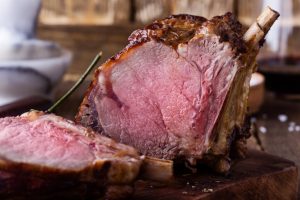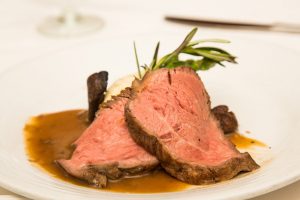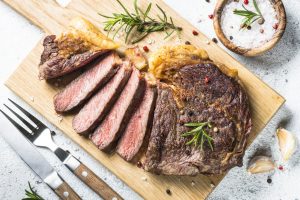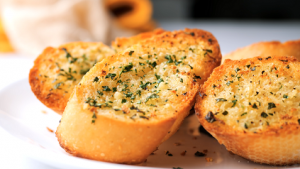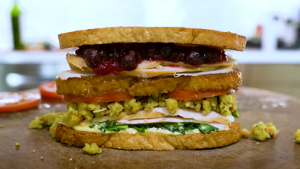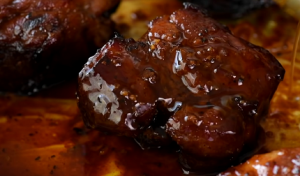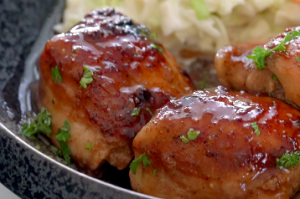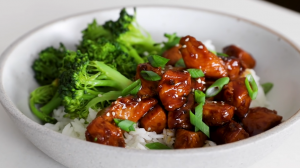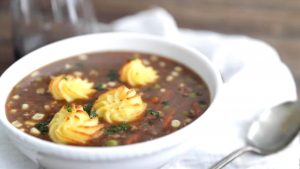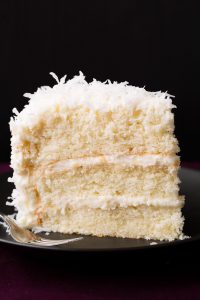A perfect garlic prime rib recipe is a showstopper at any dinner table. This slow-roasted prime rib is seasoned with a fragrant combination of garlic, rosemary, and thyme. The meat is juicy, tender, and full of flavor, making it a favorite for holiday dinners and special occasions. Top it off with a zesty citrus gremolata for a refreshing twist that cuts through the richness of the meat.
Most of the ingredients for this recipe are probably already in your pantry, like garlic, salt, and pepper. However, you might need to plan a trip to the grocery store for the prime rib roast and fresh herbs. Prime rib, also known as standing rib roast, can be found in the meat section of most supermarkets but may need to be ordered in advance during the holiday season. Fresh thyme and rosemary are usually available in the produce section; they add an earthy depth of flavor that pairs well with the robust taste of the prime rib.
Garlic Prime Rib Ingredients
Garlic: A powerfully aromatic ingredient that adds a deep, robust flavor to the prime rib.
Thyme: An herb with a subtle, dry aroma and a slightly minty flavor.
Rosemary: A fragrant herb with a pine-like flavor, perfect for enhancing the taste of the prime rib.
Canola oil: An oil with a mild flavor used to help create a crisp, golden crust on the prime rib.
Kosher salt: A type of coarse salt that enhances the natural flavors of the meat.
Black pepper: Adds a slight heat and complexity to the overall flavor profile of the prime rib.
Prime rib roast: A cut of beef from the primal rib, known for its tender, flavorful meat.
Parsley: A versatile herb that adds a fresh, lightly bitter note to the gremolata.
Lemon zest: Adds a tangy, citrus note to the gremolata, balancing the rich flavors of the prime rib.
One reader, Karleen Correa says:





This garlic prime rib recipe is a game-changer! The flavors are out of this world, and the meat is incredibly tender. The citrus gremolata adds a refreshing twist. It's a show-stopping dish that has become a family favorite. I highly recommend trying it for a special occasion or a delightful Sunday dinner.
Techniques for Cooking Perfect Garlic Prime Rib
How to prepare prime rib: This involves preparing the prime rib by mixing the garlic, thyme, rosemary, canola oil, kosher salt, and black pepper in a small bowl and rubbing it all over the prime rib. Then, letting the meat rest for 1 hour to come to room temperature.
How to cook prime rib: This involves cooking the prime rib in the oven at 450 degrees F for 20 minutes before lowering the temperature to 325 degrees F and cooking for an additional 90 minutes to 2 hours, until the meat thermometer registers between 125 to 130 degrees F.
How to make citrus gremolata: This involves mixing the parsley, garlic, and lemon zest in a small bowl to create the citrus gremolata, which is served on top of the prime rib.
How To Make Perfect Garlic Prime Rib
Serve a delicious meal with this garlic prime rib seasoned with thyme and rosemary, cooked to a perfect medium, then topped with gremolata.
Serves:
Ingredients
For Prime Rib:
- 3tbspgarlic,minced
- 4leavessprigs thyme,torn from stem
- 2leavessprigs rosemary,torn from stem and minced
- 2tbspcanola oil
- 1tbspkosher salt
- 1tspblack pepper
- 7lbsprime rib roast,boneless
For Citrus Gremolata:
- ½cupfresh parsley,minced
- 5clovesgarlic,minced
- 1tbsplemon zest,grated
Instructions
-
Add the garlic, thyme, rosemary, canola oil, kosher salt, and black pepper to a small bowl and mix.
-
Rub all over the prime rib and let rest for 1 hour to let the meat come to room temperature.
-
Heat the oven to 450 degrees F.
-
Place the prime rib, fat cap side up in a roasting pan.
-
Place the meat thermometer into the side of the roast not touching the bones and as far in as possible.
-
Cook for 20 minutes at 450 degrees F before lowering temperature to 325 degrees F.
-
Cook an additional 90 minutes to 2 hours depending on the size of the roast and the meat thermometer. It should register between 125 to 130 degrees F.
-
Let it rest for 20 minutes.
-
Serve topped with a gremolata.
Citrus Gremolata:
-
Mix the parsley, garlic, and lemon zest in a small bowl. Set aside until rib roast is ready to be served.
Nutrition
- Calories: 1459.65kcal
- Fat: 129.57g
- Saturated Fat: 52.90g
- Trans Fat: 0.01g
- Monounsaturated Fat: 56.94g
- Polyunsaturated Fat: 5.63g
- Carbohydrates: 4.03g
- Fiber: 1.53g
- Sugar: 0.12g
- Protein: 64.91g
- Cholesterol: 285.76mg
- Sodium: 920.52mg
- Calcium: 81.11mg
- Potassium: 1142.74mg
- Iron: 7.97mg
- Vitamin A: 30.35µg
- Vitamin C: 13.43mg
Pro Tip for Achieving the Perfect Prime Rib
When preparing your prime rib, it's crucial to let it rest after cooking. This allows the juices to redistribute throughout the roast, resulting in a more flavorful and moist cut of meat. Additionally, when applying the garlic and herb rub, make sure to massage it deeply into the meat. This will help the flavors to penetrate more effectively, enhancing the overall taste of your roast. Lastly, remember to place the meat thermometer correctly - it should be inserted into the thickest part of the roast, away from the bone, for the most accurate reading.
Time-Saving Tips for Making Prime Rib
Plan ahead: Prep all your ingredients and tools before starting to cook to avoid any last-minute rushes.
Multitask: While the prime rib is resting, use that time to prepare the gremolata and any side dishes to save time.
Invest in a meat thermometer: Using a meat thermometer ensures that your prime rib is cooked to perfection without the need for constant checking.
Use a roasting rack: Placing the prime rib on a roasting rack allows for even air circulation, resulting in a more evenly cooked roast.
Let the meat rest: Allowing the prime rib to rest after cooking ensures that the juices redistribute, resulting in a juicier and more flavorful roast.
Sharp knives: Keep your knives sharp to make the prep work more efficient and safer.
Clean as you go: Wash and put away utensils and dishes as you cook to minimize the cleanup time after the meal.
Organize your workspace: Keep your cooking area organized to avoid wasting time searching for ingredients and tools.
Substitute Ingredients For Perfect Garlic Prime Rib Recipe
garlic - Substitute with shallots: Shallots have a similar pungent and sweet flavor to garlic, making them a suitable substitute in many recipes. They can add depth and complexity to the dish just like garlic.
thyme - Substitute with oregano: Oregano has a similar earthy and slightly minty flavor to thyme, and it can provide a delicious aromatic quality to the dish.
rosemary - Substitute with sage: Sage has a slightly peppery and earthy flavor similar to rosemary, and it can complement the prime rib well, adding a unique and savory taste.
canola oil - Substitute with olive oil: Olive oil can be a healthier alternative to canola oil and can also add a rich and fruity flavor to the prime rib.
kosher salt - Substitute with sea salt: Sea salt can provide a similar level of saltiness and can enhance the natural flavors of the prime rib.
lemon zest - Substitute with orange zest: Orange zest can offer a similar citrusy aroma and flavor to the gremolata, adding a bright and refreshing element to the dish.
Presenting the Perfect Garlic Prime Rib
Elevate the prime rib: Carefully slice the prime rib into even, thick slices, and arrange them on the plate in an elegant and visually appealing manner.
Garnish with fresh herbs: Sprinkle the dish with freshly picked thyme and rosemary to add a pop of color and a burst of aromatic freshness.
Drizzle with jus: Spoon a small amount of rich, flavorful prime rib jus over the sliced meat to enhance the overall flavor and presentation.
Add a touch of gremolata: Sprinkle the citrus gremolata over the prime rib for a zesty, vibrant finish that complements the richness of the meat.
Serve with a side of roasted vegetables: Accompany the prime rib with a medley of roasted root vegetables and crispy potatoes for a well-rounded and visually stunning presentation.
Essential Tools for Making Prime Rib
- Garlic press: A garlic press is a handy tool for quickly and efficiently mincing garlic cloves without the need for a knife.
- Chef's knife: A sharp chef's knife is essential for trimming the prime rib and preparing the garlic and herbs.
- Cutting board: A sturdy cutting board provides a safe and stable surface for chopping and preparing the ingredients.
- Roasting pan: A roasting pan is used to cook the prime rib in the oven, allowing for even heat distribution and easy cleanup.
- Meat thermometer: A meat thermometer ensures that the prime rib is cooked to the perfect temperature, resulting in a juicy and tender roast.
- Small bowl: A small bowl is used for mixing the garlic, herbs, and oil to create the flavorful rub for the prime rib.
- Mixing spoon: A mixing spoon is essential for combining the garlic, herbs, and oil to create the flavorful rub for the prime rib.
- Serving platter: A serving platter is used to present the prime rib once it is cooked and ready to be served.
- Citrus zester: A citrus zester is used to create the lemon zest for the citrus gremolata, adding a bright and zesty flavor to the dish.
Storing and Freezing Leftover Prime Rib
Let the prime rib cool completely before storing or freezing. This will prevent condensation from forming and affecting the quality of the meat.
If you plan to consume the leftover prime rib within 3-4 days, store it in an airtight container or wrap it tightly with plastic wrap and refrigerate.
To freeze the prime rib:
- Slice the meat into desired portions, making sure to remove any bones.
- Wrap each portion tightly with plastic wrap, ensuring no air pockets remain.
- Place the wrapped portions in a freezer-safe container or a resealable freezer bag, removing as much air as possible before sealing.
- Label the container or bag with the date and contents for easy identification.
- Freeze for up to 2-3 months for optimal quality.
To reheat frozen prime rib:
- Thaw the desired portion in the refrigerator overnight.
- Preheat the oven to 250°F (120°C).
- Place the thawed meat in a baking dish and cover with foil to prevent drying out.
- Reheat in the oven for about 20-30 minutes, or until the internal temperature reaches 135°F (57°C).
- Remove from the oven and let it rest for 5-10 minutes before serving.
Alternatively, you can reheat smaller portions of prime rib in the microwave:
- Place the thawed meat on a microwave-safe plate and cover with a damp paper towel.
- Microwave on medium power (50%) for 1-2 minutes per portion, or until heated through.
- Let it rest for 1-2 minutes before serving.
Store any leftover citrus gremolata in an airtight container in the refrigerator for up to 3 days. It can be used to add flavor to other dishes or as a garnish for reheated prime rib.
How To Reheat Prime Rib Leftovers
The best way to reheat leftover prime rib is to slice it into individual portions and reheat it slowly in the oven. Preheat your oven to 250°F (120°C) and place the slices on a baking sheet. Cover the slices with foil to prevent them from drying out. Heat for about 10-15 minutes, or until the internal temperature reaches 120°F (50°C).
Another method is to use a sous vide machine. Place the sliced prime rib in a vacuum-sealed bag and heat it in a water bath at 120°F (50°C) for about 30 minutes. This method ensures that the meat is heated evenly and doesn't lose any of its juiciness.
If you're short on time, you can also reheat the prime rib in the microwave. Place the slices on a microwave-safe plate and cover them with a damp paper towel. Heat on high for 30-second intervals, checking the temperature after each interval. Be careful not to overheat the meat, as it can quickly become tough and dry.
For a quick and easy option, you can also reheat the prime rib in a skillet on the stovetop. Heat a small amount of butter or oil in the skillet over medium heat. Add the slices and cook for 1-2 minutes on each side, or until heated through.
Regardless of the method you choose, be sure to let the reheated prime rib rest for a few minutes before serving. This allows the juices to redistribute throughout the meat, ensuring that it remains tender and flavorful. Serve with your favorite sides and enjoy your leftover prime rib as much as you did the first time around!
Interesting Facts About Prime Rib
The prime rib is also known as the standing rib roast, as it is often roasted in a standing position. This method allows the meat to cook evenly and retain its natural juices, resulting in a tender and flavorful roast.
Is Making Prime Rib at Home Cost-Effective?
This garlic prime rib recipe is a luxurious yet cost-effective option for a special occasion. The flavorful blend of garlic, thyme, and rosemary creates a delectable crust on the prime rib. While the prime rib itself may be a bit pricey, the simple ingredients used for the rub and gremolata are budget-friendly. The approximate cost for a household of 4 people would be around $60-$70. The overall verdict for this recipe would be a solid 9, considering the impressive flavors and the cost-effectiveness for a special family dinner.
Is Prime Rib Healthy or Unhealthy?
The perfect garlic prime rib recipe is a decadent and flavorful dish, but it may not be the healthiest choice for everyday meals. Here's why:
- High in saturated fat: Prime rib is a fatty cut of beef, and this recipe uses a 7-pound roast, which can contribute to a significant amount of saturated fat in the diet. Excessive consumption of saturated fat has been linked to an increased risk of heart disease and other health issues.
- High in sodium: The recipe calls for 1 tablespoon of kosher salt, which can add a considerable amount of sodium to the dish. High sodium intake can lead to elevated blood pressure and other health concerns.
- Limited vegetables: While the citrus gremolata adds a touch of freshness with parsley and lemon zest, the recipe itself does not include a significant amount of vegetables, which are essential for a balanced and nutritious meal.
To make this recipe healthier, consider the following suggestions:
- Reduce the portion size of the prime rib and pair it with a generous serving of roasted or steamed vegetables to balance out the meal.
- Opt for a leaner cut of beef, such as a top sirloin roast, which has less saturated fat compared to prime rib.
- Decrease the amount of salt used in the recipe, and instead, rely on the herbs and garlic to provide flavor.
- Prepare a lighter, herb-based sauce or condiment to accompany the meat, such as a chimichurri or a horseradish yogurt sauce, which can add brightness and tang without the heaviness of traditional gravy.
- Serve the prime rib with whole grain sides, such as quinoa or brown rice, to increase the fiber content of the meal.
Editor's Opinion on This Garlic Prime Rib Recipe
The prime rib recipe is a classic and elegant choice for a special occasion. The combination of garlic, thyme, and rosemary creates a robust flavor profile, while the canola oil helps to achieve a beautiful crust on the roast. The cooking instructions are precise, ensuring a perfectly cooked prime rib with a juicy and tender texture. The addition of citrus gremolata adds a refreshing and bright element to complement the richness of the meat. Overall, this recipe is a delightful choice for a memorable dining experience.
Enhance Your Perfect Garlic Prime Rib Recipe with These Unique Side Dishes:
Similar Recipes to Perfect Garlic Prime Rib
Appetizer and Dessert Pairings for Prime Rib Dinner
Why trust this Perfect Garlic Prime Rib Recipe:
This prime rib recipe is a guaranteed crowd-pleaser, featuring garlic, thyme, and rosemary for robust flavor. The method ensures a perfectly juicy and tender roast, with a mouthwatering citrus gremolata to elevate the dish. Trust the expertise behind this recipe, as it promises a delightful dining experience for any occasion.
Was this page helpful?
Have your own special recipe to share? Submit Your Recipe Today!

